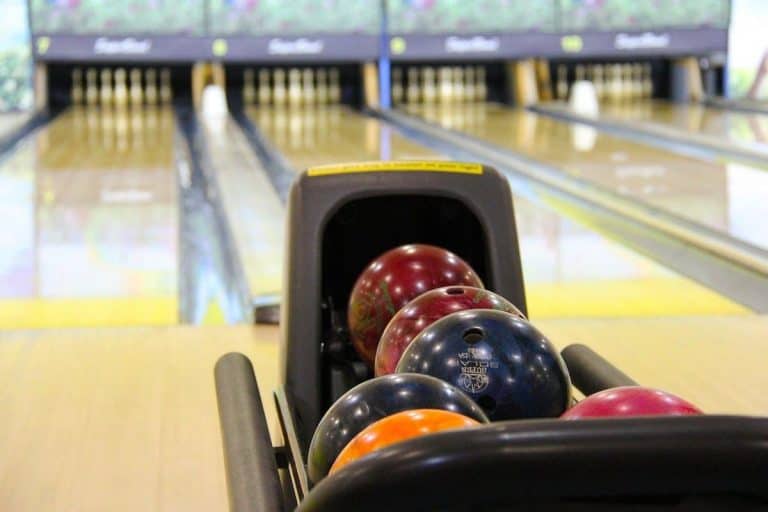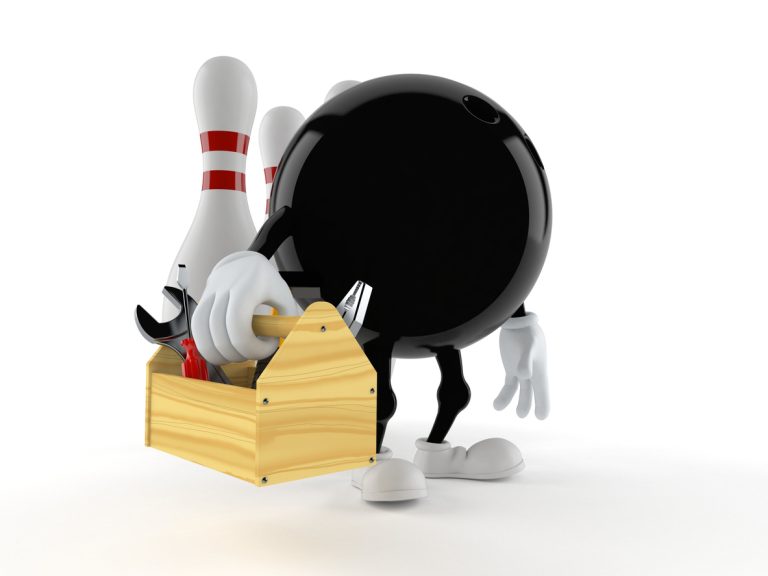Why Your Bowling Ball Hooks Too Early
Bowling lanes tend to lose the lane oil after extended use. As the oil begins to break down from the front end of the bowling alley and continues all the way till the back end, a lot of variability emerges in the behavior of the lane. If your bowling ball does not perform optimally, it could be taken as a sign that there is an underlying problem that needs to be addressed first.
The reason why your bowling ball hooks too early could be due to the lane being too dry. To mitigate this, you could adjust your feet’s position as you approach the alley and the target’s sighting more towards the center to avoid the bowling ball from hooking up too early.
In this article, I will cover more details on why the bowling ball tends to hook too early, the factors influencing this particular development, and what you can do to remedy the situation. I’ll throw in some great tips on making in-game adjustments to counter this situation.
Understanding Why the Bowling Ball Hooks Too Early
Unlike other sports where you compete head to head against another person, in bowling there is no direct defense. Instead, the biggest external factor affecting your performance is the oil conditions of the lane. As the oil pattern changes during a game, certain areas of the bowling lane also change as the oil drains off its surface and breaks up to form new patterns. This breaking of oil happens from the front end to the back end of the alley.
As this progresses, there is increased friction in the area where the oil has dried up. When a bowling ball is struck down such an alley with patches of dry spells and oil in the other regions, the bowling ball starts to hook too soon. But there are ways to throw a great hook that does not give in this easily, as you will see in the subsequent paragraphs of this article.
The Importance of Making In-Game Adjustments
Making in-game adjustments holds as true for the game as it does in life. We have often made course corrections in different circumstances and stages of our lives. Think of the bowling alley the same way. As the oil pattern changes, you will need to up your game, or at least make some course corrections so that the bowling ball always stays in the straight path and scores a strike.
Making these adjustments are quite simple, really. It might have to do with how you position your feet or the sighting that needs to be aligned now or even moving slightly in the direction of the miss. But in the long run, these small adjustments will pay off high dividends.
Move Towards the Direction Where You Have Missed
When the bowling ball hooks too soon, notice the direction the ball took before it missed and then move towards that direction while having your eyes set on the same target as before. For example, if the bowling ball misses to the right of the target, then you need to move slightly right when you next approach.
It is a fairly simple rule and easy to remember – to move in the miss direction. Nonetheless, it is also a cardinal rule and must be remembered at all times in the bowling alley.
Learn to Make Adjustments
Again, this game draws parallels from life itself. You need to learn to make a few adjustments to address the change in the game. As the oil pattern changes, any adjustment you make must be made, keeping this fact in mind. The oil patch is not the same throughout the bowling alley.
There are two major kinds of adjustments that may be made: angular adjustments and parallel adjustments.
Angular Adjustments
This is the most commonly practiced adjustment technique used to adapt to the change in the lane’s oil pattern.
Say, for instance, you are standing on the 20th board to begin your bowling session, and your target sighting is on the 10th board. Still, as the lanes start to hook, even more, you would benefit by moving your starting position slightly, say by moving one board distance either to the left or right, as you see fit. But all this while keeping your target in the same position. This is an example of angular adjustment.
If you need to move further, these small adjustments might not be enough for you, and you will need to understand the principle on which angular adjustment works – which is the rule of 2 and 1. This means that for every two boards you move, your target moves in the same direction as you but only for one board.
Using the same example as above, if you were standing on the 20th board and your target was on the 10th board and moved two boards to the 22nd board, the target will need to move by one board to the 11th board when you are aiming. The same ratio can be applied if you are moving even more boards – 2 and 1 – 2 boards for you is one for the target in the same direction.
Parallel Adjustments
There may be instances, though, where angular adjustments may not work sufficiently. In such cases, considering parallel adjustments might do the trick. A parallel adjustment requires you to move directly in the direction of the target. If you move two boards to the left, your target also moves two boards to the left.
You can further increase your chances of hitting the target by adjusting the trajectory of the bowling ball. Aim at a target closest to the foul line will cause you to lay the ball down earlier and cause you to hit the target.
The Pain of the Corner Pins
It is quite painful to see that there are two pins on either corner standing still after your first approach and hit. It is quite impossible to get to them in one shot as they are literally in two opposite directions. It is frustrating, no doubt, but it is not something that cannot be cured.
To understand how to eliminate this problem, it is important first to understand the essentials of a perfect strike. A perfect strike is one where no pins are standing. For this, the bowling ball needs to hit the 1-3 pins hard and use the same momentum as it carries on to the 5 and 9 pockets.
In a perfect strike, there is a bit of the Domino effect in play. For instance, the 3rd pin hits the 6th pin, which then hits the 10th pin in the corner. In case there is a miss out in any one of these steps, the last pin is not likely to fall. So the force has to carry on from the first pin near the front and center all the way to the last pin in the corner.
Find the missing link – that is, the pin that did not exert the necessary force to throw over the next in line, and try to understand what went wrong in there.
If the 6th pin falls back without hitting the 10th pin, it could mean that you are hitting the headpin very high, and the force dissipates as it tumbles over to the next pin in line before completely vanishing, which results in pin 10 continuing to stand. Lack of oil in the bowling alley is often the reason behind this dissipation of momentum.
In such a case, it is again important to adjust your position slightly towards the direction of the miss while keeping the target in the same lock. You could also move your target a little further down the lane and try your strike once again.
If the 6th pinheads straight to the gutter, that means you are not hitting right in the 1-3rd pockets, and you need to modify the angle of your approach so that the 3rd pin hits the 6th pin, and the same force is carried forward to the 10th pin. For this, you will need to adjust by moving your feet slightly towards the right and keeping your target closer to the foul line.
If you are left-handed, then reverse the strategy and move slightly in the opposite direction instead, and it will work just fine for you as well. In a left-handed person’s case, the 7th pin and the direction of the 4th pin will be key in finding out why it was not a perfect strike.
How to Prevent the Bowling Ball From Hooking Too Early
There are various techniques to reduce the bowling ball from hooking on too early, especially in dry lanes.
Focus on the Bowling Ball’s Speed
One of these techniques is by monitoring the speed of the ball. To overcome the dryness of the bowling alley due to the oil’s erratic pattern, increasing the speed of the ball will definitely help.
This is a simple trick, and the increase in speed can be easily achieved by increasing the swing velocity when the bowling ball is in your hands and just before you throw. The increased velocity, both when you are doing the front swing and the backswing, will be followed through as you release the ball on the bowling alley.
While you are increasing the bowling ball’s velocity, you can also consider increasing its height over the foul line. This will effectively reduce the alley’s length, thereby making it easier for you to score the perfect strike.
Consider Changing the Bowling Ball
Another reason why the bowling ball hooks too soon could be because the bowling ball is not right for the bowling lane. Usually, bowling balls that are made of polyester or urethane are good options to deliver a strike. The rule of thumb is to use a ball with a smooth surface area, and the drilled holes do not cause any rough and uneven edges around it.
By making this simple change too, you can see a massive difference in your scorecard. A proper bowling ball will remain on the straight line in which it was intended in the first place and does not change course even if the back end of the bowling lane is dry and does not have any oil.
Minimize the Use of Polish on the Bowling Bowl
Often, the polish used on the bowling ball tends to make it less smooth, thus causing more friction when it is thrown down the bowling lane. The friction leads to undesired results, and the ball is more likely to change course, and the rough surface only adds to the problem.
The key is to minimize polish use, especially those polishes that increase friction on a dry surface. While it is necessary to maintain the bowling balls, there is no need for excessive care by putting too much product on the ball, ultimately proving detrimental to the game.
Change the Alignment
The strike alignment is quite similar to the angle you take to deliver the strike. In this article, the aspect of angular and parallel adjustments has already been discussed. If you could also change your strike alignment to form a wider angle at the release point, it could also make a difference.
A wider angle at the very point of release on the front end of the lane by positioning your feet at the point of approach will help compensate to a large extent the changing oil pattern and subsequent dryness on the bowling lanes.
Consider Changing the Release Technique
The lesser the oil, the less finger rotation at the time of the release of the bowling ball – this is the simple mantra. So, if you are up against a dry bowling lane and you do not want the bowling ball to hook too early, ensure that you do not rotate your fingers at the moment of release.
Rotating fingers during release starts off a spinning action in the bowling ball. Add to this the erratic slick and dry nature of the bowling lane, and you are faced with the problem of the bowling hooking too soon. A straightforward release without the fingers’ rotation will encourage the ball to stay on course and make the strike that you are actually going for.
Lesser rotation ensures that there is a negligible axis tilt. It also ensures that your hand stays directly behind the bowling ball at the release time, thereby increasing the velocity during the follow-through action. Doing this will also increase the ball rotating chances in an end-over-end fashion keeping the ball in one straight line and reducing the chances of an early hooking considerably.
In this video, you will gain more insights and tips on how to hook a bowling ball more effectively:
The Power of Combination Effect
Of course, the best results are obtained when all these points, as discussed above, can be combined to make the alchemy of a winning formula. So if you could change the bowling ball from a rough-edged one to one with a smooth surface and less coarse texture, and combine it with angular adjustments and other alignments to increase the ball’s probability of delivering a strike, then the bowling ball is less likely to hook too early.
Eliminating finger rotation during the release of the bowling ball will help as well in this case, and it will work together with all the other steps you have taken to reduce the chances of the bowling ball hooking too soon.
Each of these factors is both the reason and the remedy for bowling balls that hook too early. With the right approach, rather, a combination of approaches, these factors that lead to the early hooking can be obliterated.
Practice, Practice, Practice
Finally, it is a well-known fact that everything is easier in theory; and the same goes for bowling. Things are much easier said than done. To be proficient in overcoming your nemesis, which in this case is the dry bowling lane that causes the ball to hook too early, you will need to put in a lot of practice.
Try to practice in a set up where the oil breaks gradually from the front end of the lane to the back, leaving behind patches of the dry lane behind. The more you practice in a similar setup, the more likely you will succeed come the actual tournament day.
You can learn more in my post on Why Your Ball Goes Left and How to Fix It.
Conclusion
Hopefully, this article has given you an understanding of the oil pattern and how it is affected as the game progresses over time. The change in the oil pattern affects the result of each bowling attempt. This is because the oil has started to break, making the bowling ball hook much quicker than before. Once this phenomenon is understood, it becomes easy to make adjustments to your positioning and aiming of the bowling ball accordingly.
Sources
- Bowling Ball: How To Reduce Bowling Hook On Dry Lanes
- Bowl: Making In-Game Adjustments
- Beginner Bowling Tips: How to Bowl on Very Dry Bowling Lanes: Overcoming Drastic Hook
- Bowl.com: Throw a Great Hook
- Bowler’s Journal: Why More Turn Does Not Mean More Hook
- Bowling This Month: Seven Misconceptions
- Throwback Sports: Best Bowling Ball for Hooks
- Lakeside Recreation Centre: Bowling Tips







